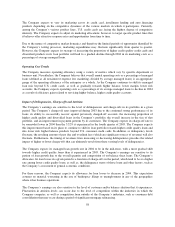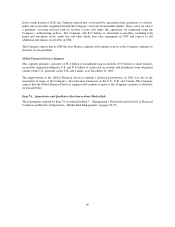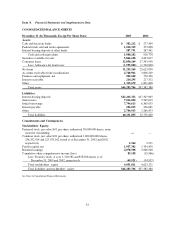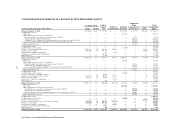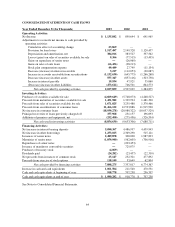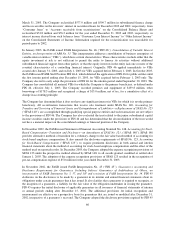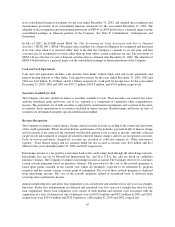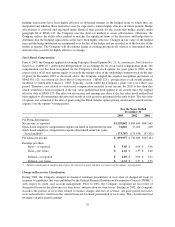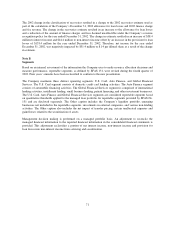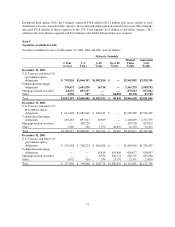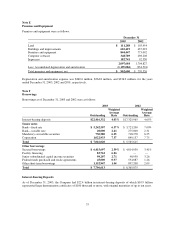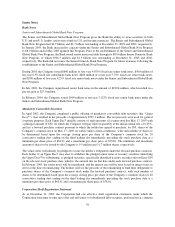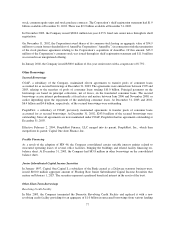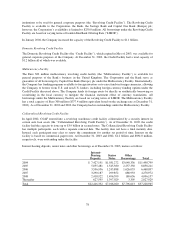Capital One 2003 Annual Report Download - page 86
Download and view the complete annual report
Please find page 86 of the 2003 Capital One annual report below. You can navigate through the pages in the report by either clicking on the pages listed below, or by using the keyword search tool below to find specific information within the annual report.Loan Securitizations
Loan securitization involves the sale, generally to a trust or other special purpose entity, of a pool of loan
receivables and is accomplished primarily through the public and private issuance of asset-backed securities by
the special purpose entity. The Company removes loan receivables from the Consolidated Balance Sheets for
those asset securitizations that qualify as sales in accordance with SFAS 140. The trusts are qualifying special
purpose entities as defined by SFAS 140. For those asset securitizations that qualify as sales in accordance with
SFAS 140, the trusts to which the loans were sold are not subsidiaries of the Company, and are not included in
the Company’s consolidated financial statements in accordance with GAAP. Gains on securitization transactions,
fair value adjustments related to residual interests and earnings on the Company’s securitizations are included in
servicing and securitizations income in the Consolidated Statements of Income and amounts due from the trusts
are included in accounts receivable from securitizations on the Consolidated Balance Sheets.
Gains on securitization transactions represent the present value of estimated excess cash flows the Company will
receive over the estimated life of the receivables. This excess cash flow essentially represents an interest-only
strip, consisting of the following estimates: the excess of finance charges and past-due fees over the sum of the
return paid to investors, contractual servicing fees and credit losses. To the extent assumptions used by
management do not prevail, fair value estimates of the interest-only strip could differ significantly, resulting in
either higher or lower future servicing and securitization income, as applicable.
Allowance for Loan Losses
The allowance for loan losses is maintained at the amount estimated to be sufficient to absorb probable losses,
net of principal recoveries (including recovery of collateral), inherent in the existing reported loan portfolio. The
provision for loan losses is the periodic cost of maintaining an adequate allowance. The amount of allowance
necessary is determined primarily based on a migration analysis of delinquent and current accounts and forward
loss curves. The entire balance of an account is contractually delinquent if the minimum payment is not received
by the payment due date. In evaluating the sufficiency of the allowance for loan losses, management takes into
consideration the following factors: recent trends in delinquencies and charge-offs including bankrupt, deceased
and recovered amounts; forecasting uncertainties and size of credit risks; the degree of risk inherent in the
composition of the loan portfolio; economic conditions; legal and regulatory guidance; credit evaluations and
underwriting policies; seasonality; and the value of the collateral supporting the loans. To the extent credit
experience is not indicative of future performance or other assumptions used by management do not prevail, loss
experience could differ significantly, resulting in either higher or lower future provision for loan losses, as
applicable.
The Company charges off credit card loans at 180 days past the due date, and generally charges off other
consumer loans at 120 days past the due date or upon repossession of collateral. Bankrupt consumers’ accounts
are generally charged-off within 30 days of receipt of the bankruptcy petition. Amounts collected on previously
charged-off accounts related to principal are included in recoveries for the determination of net charge-offs.
Costs to recover previously charged-off accounts are recorded as collection expense in other non-interest
expenses.
Premises and Equipment
Premises and equipment are stated at cost less accumulated depreciation and amortization. The Company
capitalizes direct costs (including external costs for purchased software, contractors, consultants and internal staff
costs) for internally developed software projects that have been identified as being in the application
development stage. Depreciation and amortization expenses are computed generally by the straight-line method
over the estimated useful lives of the assets. Useful lives for premises and equipment are as follows: buildings
and improvements—5-39 years; furniture and equipment—3-10 years; computers and software—3 years.
Goodwill
The Company performs annual impairment tests for acquisition goodwill in accordance with Statement of
Financial Accounting Standards No. 142, Goodwill and Other Intangible Assets (“SFAS 142”).
68


